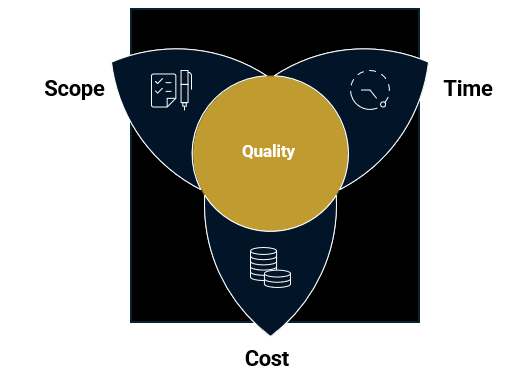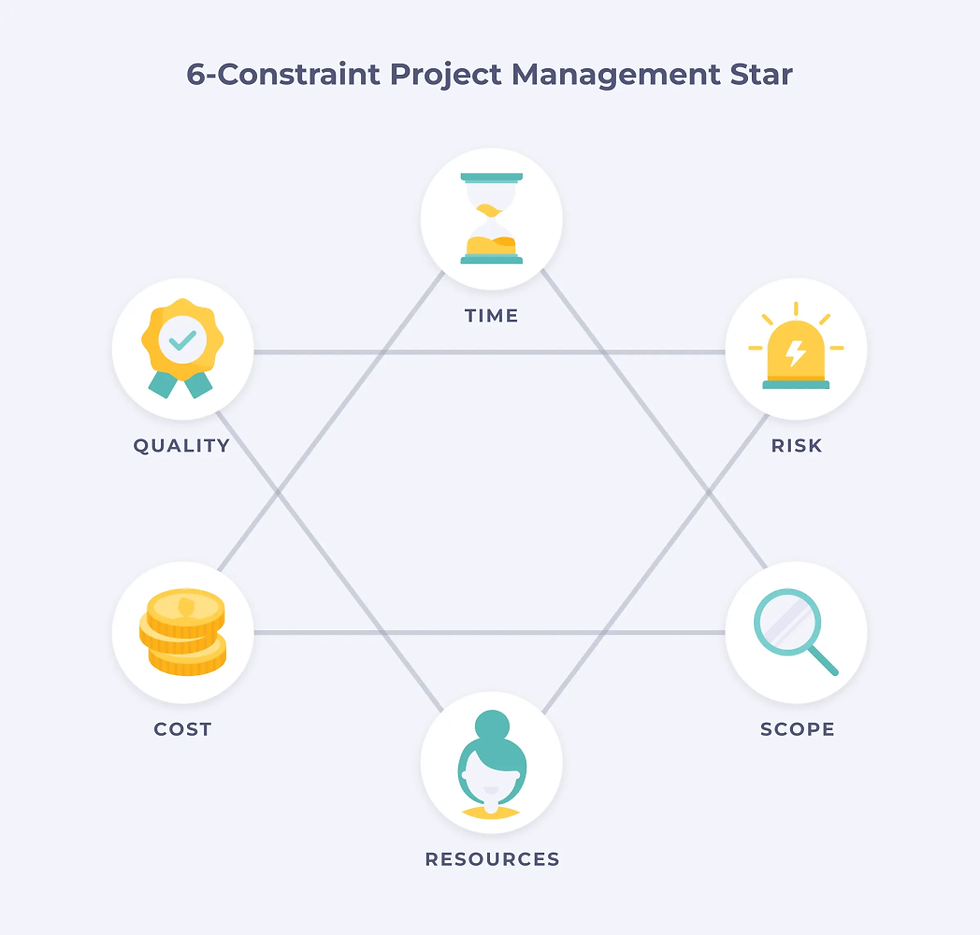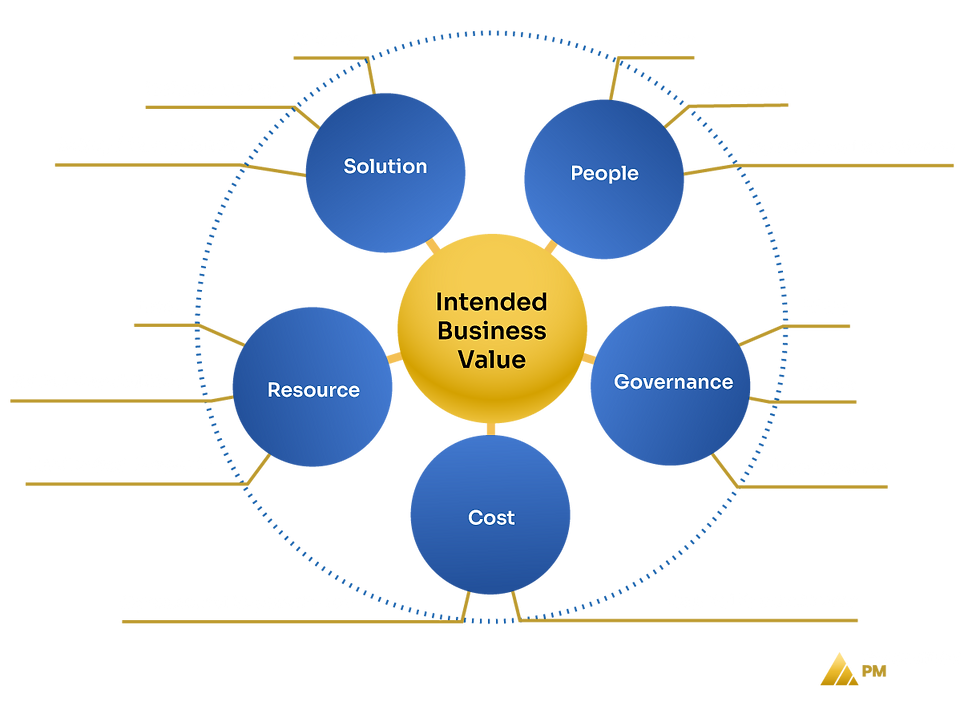Beyond Time, Scope, and Cost: The Expanded Reality of Program & Project Management
- Justin M
- Jul 7
- 6 min read
Updated: Jul 14

Regardless of size or complexity, every program or project exists to deliver meaningful outcomes.
Business leads and sponsors define the objectives that determine whether an initiative is ultimately deemed successful. In turn, program and project managers (PMs) have embraced numerous theories and frameworks to help fulfill those expectations.
Yet, as our understanding of human behavior evolves, technology accelerates, and decision-making cycles become faster and more complex, we must ask ourselves the primary question.
🔴Are our foundational theories still fit for purpose?
It’s time to revisit one of the most enduring and perhaps increasingly outdated concepts in program and project management: The Triple Constraint.
The Fundamental Theory of Program & Project Management
We’ve all heard it before: the iron or golden triangle, famously known as the triple constraint. The classic mantra goes: Pick two, but you can’t successfully manage all three.
This model shaped how we think about the trade-offs required to deliver successful initiatives. It was designed to help PMs navigate competing priorities and make informed decisions to optimize outcomes.
Let’s take a closer look at the origins and fundamentals of this theory.
First proposed by Dr. Martin Barnes in 1969, who illustrated how three key constraints collectively impact the quality of an initiative.
The theory further explains:
The quality of work is constrained by the project's budget, deadlines, and scope (features).
The PMs can trade between constraints.
Changes in one constraint necessitate changes in others to compensate, or quality will suffer.
Scope – The specific work and deliverables required to complete a project.
Time – The timeline or schedule necessary to accomplish the project’s tasks and milestones.
Cost – The budget or financial resources allocated and spent to execute the project.
There are also inherent trade-offs within the triple constraint, where modifying one element inevitably impacts the other two:
Adjusted time: When an initiative falls behind schedule, compressing timelines often leads to increased costs and may require reducing the scope to meet deadlines. Conversely, extending the timeline can drive up costs and may introduce additional activities or stakeholder requirements.
Adjusted scope: Reducing the scope typically shortens the timeline and lowers costs, as fewer tasks and resources are needed. However, expanding the scope usually increases both costs and duration due to the additional work and complexity involved.
Adjusted costs: Increasing the budget may allow for additional scope or an extended timeline to enhance delivery. Conversely, budget cuts often force a reduction in scope and require accelerated timelines, increasing risk and reducing flexibility.

Now, there are inherent challenges with relying solely on tradeoffs. For example, increasing a project’s budget to add more resources can sometimes have the unintended consequence of diminishing quality, rather than improving it.
When we examine different types of initiatives, it becomes clear that managing tradeoffs among scope, time, and cost alone is not sufficient to ensure that intended business objectives are fully realized.
The Evolution of the Triple Constraint
There is an illusion in managing an initiative that successfully handling the triple constraint equates to true success. In reality, even when scope, time, and cost are well-controlled, initiatives can still fail.
The truth is, PMs rarely have direct control over these core constraints. Timeframes, budgets, and scope are often determined during initiative development or portfolio approvals, long before execution begins.
The idea that initiative success involves more than simply managing scope, time, and cost has already prompted expansions of the original theory.
In PMBOK 4.0, the Star Model was introduced as an evolution of the traditional triple constraint. It preserved the familiar triangle structure by overlaying two triangles, one representing project inputs and outputs, and the other depicting project process factors.
This model was an important step forward, acknowledging that initiative success isn’t driven solely by balancing time, cost, and scope, but also by understanding how these constraints interact with processes.
The model details are the following:
Project Inputs and Outputs Triangle:
Scope – The defined deliverables and work required.
Cost – The budget allocated and resources expended.
Time – The schedule and deadlines associated with completion.
Project Process Factors Triangle:
Quality – The degree to which deliverables meet requirements and stakeholder expectations.
Risk – The identification, analysis, and mitigation of uncertainties that could affect objectives.
Resources – The people, materials, equipment, and facilities required to execute the work.

By combining these two dimensions, the Star Model highlighted that managing a project effectively requires balancing both tangible constraints and the processes that support successful delivery. It moved the discipline closer to a systems-thinking approach, acknowledging that successful outcomes stem from how these factors interrelate rather than from managing them in isolation.
The V5 Model, Project Success Reimagined
Building on the evolution from the Triple Constraint to the Star Model, it becomes clear that certain critical elements remain absent in achieving true business outcomes.
At its core, an initiative’s success is not defined solely by managing constraints, but by realizing the intended business value as defined by key stakeholders.
Modern success frameworks must therefore shift their focus toward prioritizing the attainment of this intended business value as the ultimate objective.
To accomplish this, PMs must actively manage specific factors, value levers that directly influence how effectively an initiative delivers on its intended outcomes.
These levers form the foundation of the V5 Model of program and project management success, centered on harnessing intended business value.
The key levers include:
People
Resource
Solution
Governance
Cost

People
No initiative can succeed without a deep understanding and deliberate management of the people component. Often overlooked in traditional theories. Effective, timely, and targeted communication with stakeholders is essential to achieving the intended business value.
Culture - Organizational culture fundamentally influences how change is communicated, received, and ultimately embraced.
Adoption - If end users or consumers do not accept the solution, the initiative fails to deliver value, especially if workarounds or resistance emerge.
Operational readiness - Poorly designed change management leaves stakeholders unprepared, causing costly value erosion post-deployment.
Resource
Beyond the well-known triple constraint of time, other organizational resources are critical to success. Understanding and managing these ensure the realization of intended business value.
Time - Initiative duration influences return on investment and value delivery speed.
Skills/capabilities - The expertise of stakeholders and SMEs directly impacts outcome achievement. Skill gaps can erode value and introduce liabilities.
Intellectual property - Leveraging existing intellectual property, or acquiring new IP, can enhance the value generated by an initiative and provide a competitive advantage.
Solution
How well a solution aligns with business needs without creating additional problems significantly affects value realization.
Quality - Poor-quality outcomes undermine adoption, increase rework, and delay delivery.
Holistic design - Addressing upstream/downstream dependencies and both explicit and implicit requirements ensures full support of business objectives.
Safety/compliance - Neglecting legal or regulatory mandates risks feasibility and can cause punitive consequences, threatening success and reputation.
Governance
Strong governance influences decision-making, escalation, and scope management, which either protects or erodes intended value. Without it, value can diminish even before project completion.
Risks - Timely, comprehensive risk management protects value and stakeholder trust.
Scope - Beyond protecting the defined scope, identifying valuable additional scope is key to maximizing outcomes.
Prioritization - Empirical prioritization avoids distractions and preserves potential value.
Cost
Financial management remains a fundamental lever linked to the original triple constraint. Both operational and capital expenditures are crucial to value realization.
Operational expenditures (OPEX) - Ongoing costs required to run the initiative, including staffing, maintenance, and day-to-day expenses that sustain initiative activities and operational readiness.
Capital expenditures (CAPEX) - One-time investments in physical assets, technology, or infrastructure essential for delivering the initiative's solution and long-term value.
Each of these five levers must be actively managed to achieve the full spectrum of intended business value. Neglecting even one can lead to costly consequences that only become evident after an initiative is declared “complete.” Understanding and balancing all five is essential for today’s program and project management success.
From PM to Business Advocate
Program and project management will continue to evolve, driven by advances in technology, shifting business dynamics, and a deeper understanding of human behavior. This article offers a new perspective on how we should define success in today’s initiatives.
Some will cling to established frameworks, drawn to their simplicity and widespread acceptance. But doing so risks overlooking a critical question: Do these theories genuinely prevent failure, or do they merely offer a convenient narrative when projects go off course?
As practitioners, how we define success matters. It shapes how we plan, make decisions, and ultimately how we advocate for the business. Because today, success isn’t just about delivering on time, in scope, and on budget, it’s about becoming a business advocate who protects and realizes intended business value.
--
Pragintion PM, we specialize in navigating ambiguity and high-stakes environments tied to complex initiatives.
Our program & project management services are grounded in a pragmatic, intentional approach delivered through a client-validated methodology that gets results.
Found this article helpful?
✅ Share it with your network
📌 Save it for future reference
Follow Pragintion PM for more insights on driving real business value from complex programs and projects.

- J&A TBC LLC 2025©



